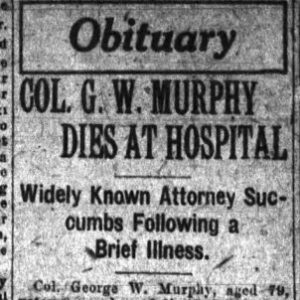calsfoundation@cals.org
George Washington Murphy (1841–1920)
George Washington Murphy’s career as a soldier and lawyer spanned sixty years and included an ideological journey from defending the Confederacy and slavery to seeking the liberation of twelve innocent Black men who had been sentenced to death following the events of the Elaine Massacre of 1919. Murphy was elected attorney general of Arkansas twice at the beginning of the twentieth century and, in 1913, ran for governor, unsuccessfully, on the Progressive Party ticket.
George Murphy was born on January 8, 1841, in Huntingdon, Tennessee, north of Memphis, to Joseph Robertson Murphy and Grace Leslie Murphy. A few weeks before Tennessee formally seceded from the Union, in June 1861, Murphy, then twenty years old, enlisted in the Confederate army. He was wounded in the Battle of Shiloh; shot in his right shoulder at Murfreesboro; and shot in his left arm, right hand, and right leg at Harrisburg. The injuries sidelined him for periods, but he remained in the army until the war’s end. His shoulder and leg wounds left him slightly disabled the rest of his life, although he often magnified his injuries in court to gain sympathy from juries for his clients.
Murphy had begun to study law before the Civil War. When the war ended in 1865, he moved to Hamburg (Ashley County) and studied law under W. D. Moore. He was licensed to practice law in 1866 and moved eleven years later to the larger city of Hot Springs (Garland County), where he soon developed a reputation as the best criminal lawyer around. He had a cunning grasp of the courtroom and of juries. He often exaggerated his limp when he walked by the jury box, and when prosecutors were making their statements, Murphy would pull out a fancy pocket watch and play with it at the defense table to distract the jury.
In an article in the Arkansas Gazette the day after Murphy’s death, Circuit Judge John W. Wade, who had presided at a trial in Little Rock (Pulaski County) several days earlier in which the aged Murphy defended a man, remarked about his rare ability as a trial lawyer: “His body was feeble, but his mind was as brilliant as ever. In his argument to the jury he took up one at a time each badge of guilt relied on by the state and artfully contended that each one was in reality evidence of his client’s innocence. More than any lawyer I ever knew, Colonel Murphy was able to concentrate on circumstantial evidence apparently so insignificant as to be overlooked by others—a flood of light so strong as to compel a vote against conviction. His originality in presenting to a jury was such that even a seeming crudeness was often intensely dramatic. This, with his wonderful reasoning faculties, made him invincible in jury trials.”
Murphy moved to Little Rock in 1890 with his wife, Sallie Halton Murphy, and the first of their six daughters. Several years later, they moved into a house at 1301 Scott Street in Little Rock, now the historic building known as the Murphy-Rozelle House. He formed a partnership with Thomas M. Mehaffy, who was later a justice of the Arkansas Supreme Court. The firm was dissolved in 1900 when Attorney General Jeff Davis was elected governor and Murphy was elected attorney general; he was reelected two years later. He returned to private practice at Little Rock in 1905. In 1913, when the newly elected governor, Joseph T. Robinson, resigned to become U.S. senator upon the death of Senator Jeff Davis, Murphy abandoned the Democratic Party and ran for governor on the Progressive Party ticket to complete Robinson’s term. However, he finished behind the winning Democrat, George W. Hays, and the Republican, Harry W. Myers, but ahead of the Socialist, Emil Webber.
Eventually, Murphy partnered with the trial lawyers Ed L. McHaney and M. E. Dunaway, who, along with Murphy, joined prominent African American lawyer Scipio A. Jones and the National Association for the Advancement of Colored People (NAACP) in a long effort to prevent the execution of the twelve men unfairly sentenced to death following the 1919 Elaine Massacre. Before his death, Murphy, his partners, and Jones succeeded in getting the convictions of six of the condemned men reversed and new trials ordered by the Arkansas Supreme Court. Eventually, all twelve would be freed.
Murphy died on October 11, 1920, and is buried in Greenwood Cemetery in Hot Springs.
For additional information:
“Col. G. W. Murphy Dies at Hospital.” Arkansas Gazette, October 12, 1920, p. 6.
Stockley, Grif, Brian K. Mitchell, and Guy Lancaster. Blood in Their Eyes: The Elaine Massacre of 1919. Rev. ed. Fayetteville: University of Arkansas Press, 2020.
Ernest Dumas
Little Rock, Arkansas
 Law
Law Politics and Government
Politics and Government George Washington Murphy Obituary
George Washington Murphy Obituary 




Comments
No comments on this entry yet.